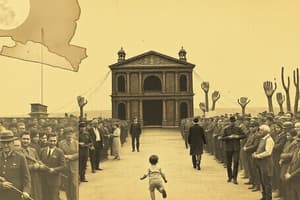Podcast
Questions and Answers
Which sentence structure is used to form the Past Continuous tense?
Which sentence structure is used to form the Past Continuous tense?
- Subject + Past Tense of 'To Be' + Base Verb in Present Participle Form -ing (correct)
- Subject + Present Participle of 'To Be'
- Subject + Present Participle of the Main Verb
- Subject + Base Verb in Past Simple Form
When forming the Past Simple tense, what is typically added to regular verbs?
When forming the Past Simple tense, what is typically added to regular verbs?
- '-s' at the end of the verb
- '-ed' to the infinitive form of the verb (correct)
- '-ing' before the verb
- '-ly' at the end of the verb
Which of the following is a correct example of Past Continuous usage?
Which of the following is a correct example of Past Continuous usage?
- He sings a song every morning.
- She walked to the park yesterday.
- They were playing football when it started raining. (correct)
- The dog barked loudly last night.
What time expressions are commonly used with the Past Continuous tense?
What time expressions are commonly used with the Past Continuous tense?
How does the Past Simple tense differ from the Past Continuous tense?
How does the Past Simple tense differ from the Past Continuous tense?
Which tense is used to describe actions that were completed at a specific time in the past?
Which tense is used to describe actions that were completed at a specific time in the past?
What is the typical sentence structure when using the Past Continuous tense with a time expression?
What is the typical sentence structure when using the Past Continuous tense with a time expression?
How can time expressions be used with the Past Simple tense?
How can time expressions be used with the Past Simple tense?
What is the main difference in the usage of time expressions between the Past Simple and Past Continuous tenses?
What is the main difference in the usage of time expressions between the Past Simple and Past Continuous tenses?
Flashcards are hidden until you start studying
Study Notes
Past Simple vs. Past Continuous
Form
The Past Continuous, also referred to as the Past Progressive, is formed using the auxiliary verb "to be" in the past tense (e.g., was/were) followed by the present participle (-ing) form of the main verb. This combination creates a sentence structure that describes an action in progress at a specific time in the past. The basic sentence structure follows the format: Subject + Past Tense of "To Be" + Base Verb in Present Participle Form.
Example: She was singing.
On the other hand, the Past Simple tense is simpler. It is typically created by adding "-ed" to the infinitive form of regular verbs (e.g., walking -> walked). Irregular verbs, however, require learning their unique past simple forms. The basic sentence structure for Past Simple is: Subject + Base Verb in Past Simple Form.
Example: He walked to the store.
Usage
Past Continuous
The Past Continuous tense is primarily used to describe actions or activities that were in progress at a particular point in the past but may or may not still be occurring. These actions are often ongoing or extended in nature. Examples include:
- Describing a series of events: "While I was sleeping, my dog barked."
- Explaining interruptions: "I was studying when my phone rang."
- Conveying habits or routines: "Every morning, I was waking up early to run."
Past Simple
The Past Simple tense, on the other hand, is used to denote actions that were completed at a specific time in the past, regardless of whether they lasted a short or long time. Examples include:
- Describing a single completed action: "Yesterday, I ate pizza."
- Expressing punctual actions: "At noon, he arrived."
- Narrating sequences of events: "First, I studied. Then, I ate lunch."
Time Expressions
Both Past Simple and Past Continuous can be used with time expressions to clarify the temporal relationships of the events described. However, the usage differs slightly depending on the tense.
For Past Simple, time expressions can be employed to indicate when an action started and ended or to establish the sequence of events. They can also be used to specify the duration of the action.
Example: Yesterday, I walked to school.
With Past Continuous, time expressions are essential for providing context about the continuity of the action in the past. The sentence structure remains consistent: Subject + Past Tense of "To Be" + Present Participle Form of the Main Verb + Time Expression.
Example: While I was studying, it suddenly rained.
Studying That Suits You
Use AI to generate personalized quizzes and flashcards to suit your learning preferences.




